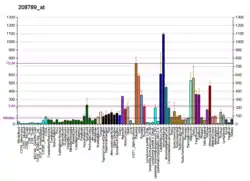PTRF
Polymerase I and transcript release factor, also known as Cavin1, Cavin-1 or PTRF, is a protein which in humans is encoded by the PTRF gene.[5][6]
| CAVIN1 | |||||||||||||||||||||||||||||||||||||||||||||||||||
|---|---|---|---|---|---|---|---|---|---|---|---|---|---|---|---|---|---|---|---|---|---|---|---|---|---|---|---|---|---|---|---|---|---|---|---|---|---|---|---|---|---|---|---|---|---|---|---|---|---|---|---|
| Identifiers | |||||||||||||||||||||||||||||||||||||||||||||||||||
| Aliases | CAVIN1, CAVIN, CGL4, cavin-1, FKSG13, PTRF, polymerase I and transcript release factor, caveolae associated protein 1 | ||||||||||||||||||||||||||||||||||||||||||||||||||
| External IDs | OMIM: 603198 MGI: 1277968 HomoloGene: 7499 GeneCards: CAVIN1 | ||||||||||||||||||||||||||||||||||||||||||||||||||
| |||||||||||||||||||||||||||||||||||||||||||||||||||
| |||||||||||||||||||||||||||||||||||||||||||||||||||
| |||||||||||||||||||||||||||||||||||||||||||||||||||
| |||||||||||||||||||||||||||||||||||||||||||||||||||
| |||||||||||||||||||||||||||||||||||||||||||||||||||
| Wikidata | |||||||||||||||||||||||||||||||||||||||||||||||||||
| |||||||||||||||||||||||||||||||||||||||||||||||||||
Function
PTRF (Cavin1) has been shown to be crucial for caveola formation and function. [7]
Termination of RNA polymerase I catalyzed transcription is a 2-step process that involves pausing of transcription elongation and release of both the pre-ribosomal RNA and Pol I from the DNA template. The pausing is mediated by TTF1 and PTRF.[8][9]
PTRF is a soluble protein containing putative leucine zipper, nuclear localization signal, and PEST domains.[10]
Interactions
PTRF (Cavin1) forms trimers with Cavin2 and Cavin3 in caveola formation and has been shown to interact with other membrane associating proteins such as EHD2 and caveolins. [11]
References
- GRCh38: Ensembl release 89: ENSG00000177469 - Ensembl, May 2017
- GRCm38: Ensembl release 89: ENSMUSG00000004044 - Ensembl, May 2017
- "Human PubMed Reference:". National Center for Biotechnology Information, U.S. National Library of Medicine.
- "Mouse PubMed Reference:". National Center for Biotechnology Information, U.S. National Library of Medicine.
- "Entrez Gene: PTRF polymerase I and transcript release factor".
- "CAVIN1 Symbol Report | HUGO Gene Nomenclature Committee". www.genenames.org. Retrieved 2017-05-30.
- Hill MM, Bastiani M, Luetterforst R, Kirkham M, Kirkham A, Nixon SJ, Walser P, Abankwa D, Oorschot VM, Martin S, Hancock JF, Parton RG (January 2008). "PTRF-Cavin, a conserved cytoplasmic protein required for caveola formation and function". Cell. 132 (1): 113–24. doi:10.1016/j.cell.2007.11.042. PMC 2265257. PMID 18191225.
- Mason SW, Sander EE, Grummt I (January 1997). "Identification of a transcript release activity acting on ternary transcription complexes containing murine RNA polymerase I". The EMBO Journal. 16 (1): 163–72. doi:10.1093/emboj/16.1.163. PMC 1169623. PMID 9009277.
- Jansa P, Mason SW, Hoffmann-Rohrer U, Grummt I (May 1998). "Cloning and functional characterization of PTRF, a novel protein which induces dissociation of paused ternary transcription complexes". The EMBO Journal. 17 (10): 2855–64. doi:10.1093/emboj/17.10.2855. PMC 1170626. PMID 9582279.
- Aboulaich N, Vainonen JP, Strålfors P, Vener AV (October 2004). "Vectorial proteomics reveal targeting, phosphorylation and specific fragmentation of polymerase I and transcript release factor (PTRF) at the surface of caveolae in human adipocytes". The Biochemical Journal. 383 (Pt 2): 237–48. doi:10.1042/BJ20040647. PMC 1134064. PMID 15242332.
- Kovtun O, Tillu VA, Ariotti N, Parton RG, Collins BM (April 2015). "Cavin family proteins and the assembly of caveolae". Journal of Cell Science. 128 (7): 1269–78. doi:10.1242/jcs.167866. PMC 4379724. PMID 25829513.
- Hasegawa T, Takeuchi A, Miyaishi O, Xiao H, Mao J, Isobe K (April 2000). "PTRF (polymerase I and transcript-release factor) is tissue-specific and interacts with the BFCOL1 (binding factor of a type-I collagen promoter) zinc-finger transcription factor which binds to the two mouse type-I collagen gene promoters". The Biochemical Journal. 347 Pt 1 (Pt 1): 55–9. doi:10.1042/0264-6021:3470055. PMC 1220930. PMID 10727401.
Further reading
- Jansa P, Mason SW, Hoffmann-Rohrer U, Grummt I (May 1998). "Cloning and functional characterization of PTRF, a novel protein which induces dissociation of paused ternary transcription complexes". The EMBO Journal. 17 (10): 2855–64. doi:10.1093/emboj/17.10.2855. PMC 1170626. PMID 9582279.
- Hasegawa T, Takeuchi A, Miyaishi O, Xiao H, Mao J, Isobe K (April 2000). "PTRF (polymerase I and transcript-release factor) is tissue-specific and interacts with the BFCOL1 (binding factor of a type-I collagen promoter) zinc-finger transcription factor which binds to the two mouse type-I collagen gene promoters". The Biochemical Journal. 347 Pt 1 (Pt 1): 55–9. doi:10.1042/0264-6021:3470055. PMC 1220930. PMID 10727401.
- Aboulaich N, Vainonen JP, Strålfors P, Vener AV (October 2004). "Vectorial proteomics reveal targeting, phosphorylation and specific fragmentation of polymerase I and transcript release factor (PTRF) at the surface of caveolae in human adipocytes". The Biochemical Journal. 383 (Pt 2): 237–48. doi:10.1042/BJ20040647. PMC 1134064. PMID 15242332.
- Rush J, Moritz A, Lee KA, Guo A, Goss VL, Spek EJ, Zhang H, Zha XM, Polakiewicz RD, Comb MJ (January 2005). "Immunoaffinity profiling of tyrosine phosphorylation in cancer cells". Nature Biotechnology. 23 (1): 94–101. doi:10.1038/nbt1046. PMID 15592455. S2CID 7200157.
- Zhang Y, Wolf-Yadlin A, Ross PL, Pappin DJ, Rush J, Lauffenburger DA, White FM (September 2005). "Time-resolved mass spectrometry of tyrosine phosphorylation sites in the epidermal growth factor receptor signaling network reveals dynamic modules". Molecular & Cellular Proteomics. 4 (9): 1240–50. doi:10.1074/mcp.M500089-MCP200. PMID 15951569.
- Aboulaich N, Ortegren U, Vener AV, Strålfors P (November 2006). "Association and insulin regulated translocation of hormone-sensitive lipase with PTRF". Biochemical and Biophysical Research Communications. 350 (3): 657–61. doi:10.1016/j.bbrc.2006.09.094. PMID 17026959.
- Olsen JV, Blagoev B, Gnad F, Macek B, Kumar C, Mortensen P, Mann M (November 2006). "Global, in vivo, and site-specific phosphorylation dynamics in signaling networks". Cell. 127 (3): 635–48. doi:10.1016/j.cell.2006.09.026. PMID 17081983. S2CID 7827573.





